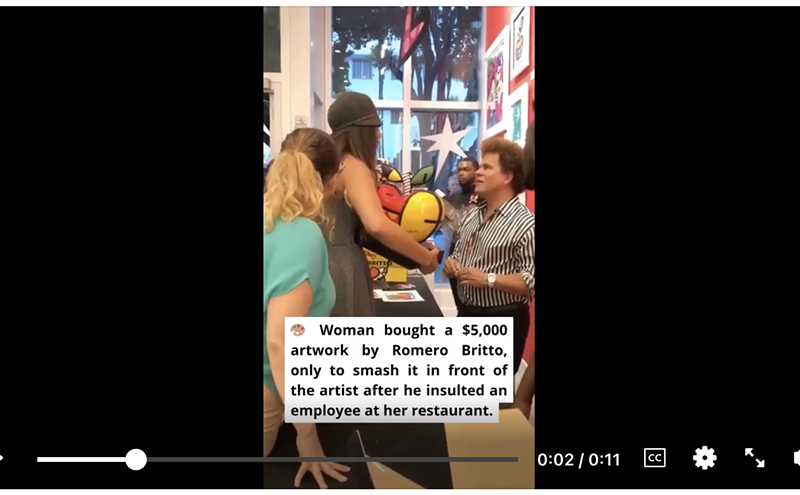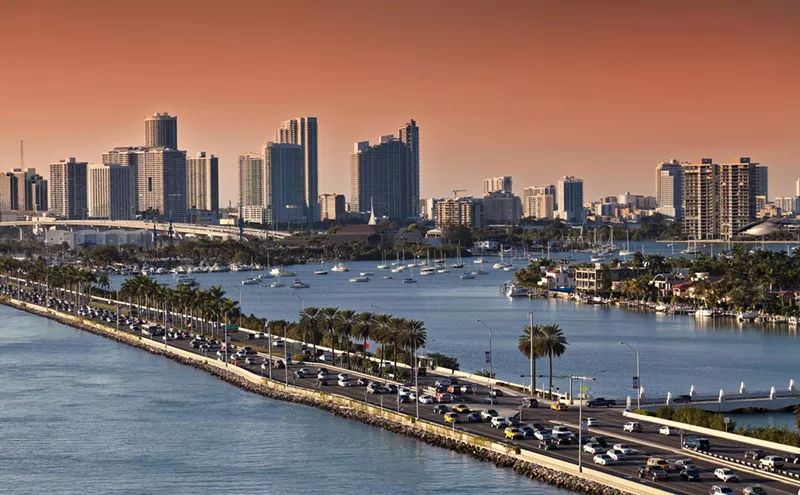Hacking scandals are a dime a dozen. From Wikileaks to Edward Snowden to the Sony debacle late last year, subversive tech-savvy hackers are using our interconnected world to undermine established power centers. Amir Baradaran is looking to use that same interconnectivity to subvert canonical art establishments across the world. The Iranian-Canadian artist uses the nascent tool of augmented reality (AR) to re-appropriate icons of Western art, and in the process push the boundaries of technology in an art context.
New Times sat down with Baradaran at the Standard Hotel in Miami Beach to get the latest on how he plans to inject his work into the South Florida community. The Standard is increasingly asserting its role in the local art community as a space where members can meet and collaborate with interesting figures in the art world. “I see The Standard as a place to meet the best and brightest creative minds Miami has to offer,” says director of membership Cybele Dewulf.
Baradaran recently hosted a talk at the hotel where he laid out the logistics of his new medium. “I’m not that interested in the nuts and bolts of technology, but more of the conversation that it can spark,” explains the artist. Baradaran sought out a team of developers who had launched a smartphone app called Junaio. He then used their technology for his work. When activated and aimed at certain objects and locations the app can augment objects in a desired way. For example, one of his recent works, Frenchising Mona Lisa (2011), had patrons of the Louvre Museum in Paris experiencing the Mona Lisa draped in a French flag in the style of a hijab.
“It was a comment on the social context at the time,” says Baradaran. “Sarkozy had just banned the wearing of Muslim headscarves in public, but I thought it was ironic that the Mona Lisa is depicted with a veil.”
The conflict between east and west is intimately ingrained in Baradaran. Born in Iran, he immigrated with his parents to Canada where he became active in the anti-war and student movements during his studies at McGill University. While his formal education mostly centered in politics and communication, he brought his interest in social engagement into his art work, first as a painter, then moving towards video and eventually AR.
“When I moved to New York, I realized that there was this weird divide between taxi drivers and passengers. I had all this background in activism so I was drawn to it as a project,” recalled Baradan. His initial interest eventually percolated into Transient (2010). The work consists of tight shots of taxi drivers looking into their rearview mirrors and directly at the camera. Baradaran hacked into the taxi company servers to display the work in their back seat monitors. The piece captures the humanizing and unsettling power of eye contact, especially when directed across socio-economic planes.
Along the same vein, Baradaran produced two works that at the Museum of Modern Art in New York. The first, Takeoff (2010), was a tongue-and-cheek subversion of the traditional art space. Through his iPhone app, museum-goers could watch an augmented video of the artist taking flight in a directors chair when aimed at one specific location within MoMA.
The second, The Other Artist Is Present (2010) was a more in-your-face confrontation of the same institution. During Marina Abramovic’s retrospective, Baradaran staged a performance with the help of over 30 close friends and assistants. “We hid things in the bathrooms and eventually got kicked out, but we got what we wanted,” beamed Baradaran.
The need to undermine these canonical institutions of Western art is very present in his work. Perhaps Baradaran feels he’s evening a score. At his talk, Augmenting the Augmentable!, he recalled how many of the ancient treasures of his native Iran were ransacked during Western colonialism and brought back to the very same institutions he is openly confronting.
So how does Baradaran plan to bring his brand of creativity to the South Florida? With the help of local entrepreneur and Bass Museum board member Brian Ehrlich, he is partnering with various neighborhoods to design and develop large interactive data sculptures. The work is a massive public arts project that marries Baradaran’s penchant for high-tech devices with his passion for communities often overlooked by the art establishment.
Ehrlich and Baradaran met during last Art Basel, quickly realizing they shared a common goal. “There’s a frustration that is palpable today with technology," says Ehrlich. "When Amir and I began working together, it really resonated with me that his art is aimed at exposing that." The Opa-locka Community Development Corporation has already pledged their support to host and partially fund the project.
Whether or not Baradaran’s seismic vision will come to fruition remains to be seen. What is certain is that all the hype surrounding his nascent medium is overblown in his eyes. “When DaVinci was trying to design an airplane it was to bring snow from the Alps to Italian villages,” he says. “Today, that seems ridiculous, but DaVinci’s initial vision did spark something very real that was an adjacent potentiality.”
In other words, it’s not so much how AR will directly impact contemporary culture, it’s more about how the debate the technology triggers engenders attitudes that can have lasting impact in the way societies delegate authority and agency. Whether you download his app or not, the coming advances in telecommunications will dramatically shift the arc of power. It’s up to the people to decide what direction that arc will turn.

Audio By Carbonatix
[
{
"name": "GPT - Billboard - Slot Inline - Content - Labeled - No Desktop",
"component": "22004575",
"insertPoint": "2",
"requiredCountToDisplay": "2"
},{
"name": "STN Player - Float - Mobile Only ",
"component": "22595215",
"insertPoint": "2",
"requiredCountToDisplay": "2"
},{
"name": "Editor Picks",
"component": "17482312",
"insertPoint": "4",
"requiredCountToDisplay": "1"
},{
"name": "Inline Links",
"component": "18711090",
"insertPoint": "8th",
"startingPoint": 8,
"requiredCountToDisplay": "7",
"maxInsertions": 25
},{
"name": "GPT - 2x Rectangles Desktop, Tower on Mobile - Labeled",
"component": "23181625",
"insertPoint": "8th",
"startingPoint": 8,
"requiredCountToDisplay": "7",
"maxInsertions": 25
},{
"name": "Inline Links",
"component": "18711090",
"insertPoint": "8th",
"startingPoint": 12,
"requiredCountToDisplay": "11",
"maxInsertions": 25
},{
"name": "GPT - Leaderboard to Tower - Slot Auto-select - Labeled",
"component": "17720761",
"insertPoint": "8th",
"startingPoint": 12,
"requiredCountToDisplay": "11",
"maxInsertions": 25
}
]











